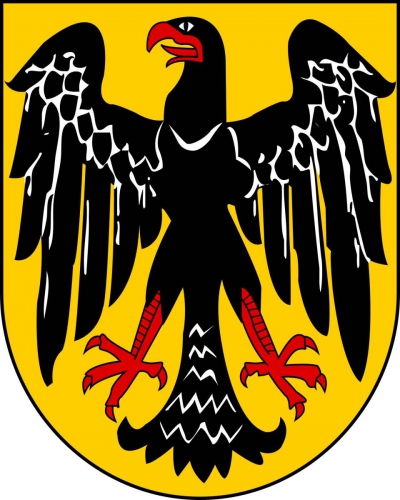The Enabling Act (German: Ermchtigungsgesetz) of 1933, officially titled Gesetz zur Behebung der Not von Volk und Reich (lit.'Law to Remedy the Distress of People and Reich'), was a law that gave the German Cabinetmost importantly, the Chancellorthe powers to make and enforce laws without the involvement of the Reichstag or Weimar President Paul von Hindenburg. Critically, the Enabling Act allowed the Chancellor to bypass the system of checks and balances in the government and the laws created under it could explicitly violate individual rights prescribed in the Weimar Constitution.In January 1933 Nazi Party leader Adolf Hitler convinced President Paul von Hindenburg to appoint him as chancellor, the head of the German government. Four weeks into his chancellorship, the Reichstag building caught fire in the middle of the night. Hitler blamed the incident on the communists and was convinced the arson was part of a larger effort to overthrow the German government. Using this justification, Hitler persuaded Hindenburg to enact the Reichstag Fire Decree. The decree abolished most civil liberties including the right to speak, assemble, protest, and due process. Using the decree the Nazis declared a state of emergency and began to arrest, intimidate, and purge their political enemies. Communists and labor union leaders were subsequently arrested and interned in Dachau, the first concentration camp constructed by the Nazi regime. By clearing the political arena of anyone willing to challenge him, Hitler submitted a proposal to the Reichstag that would immediately grant all legislative powers to the cabinet. This would in effect allow Hitler's government to act without concern to the constitution.
Despite outlawing the communists and repressing other opponents, the passage of the Enabling Act was not a guarantee. Hitler allied with other nationalist and conservative factions and they steamrolled over the Social Democrats in the March 5, 1933 German federal election. That election would be the last multiparty election held in a united Germany until 1990, fifty-seven years later, and occurred in an atmosphere of extreme voter intimidation perpetrated by the Nazis. Contrary to popular belief, Adolf Hitler did not command a majority in the Reichstag voting on the Enabling Act. The majority of Germans did not vote for the Nazi Party, as Hitler's total vote was less than 45% despite the terror and fear fomented by his repression. In order for the enabling act to be passed the Nazis implemented a strategy of coercion, bribery, and manipulation. Hitler removed any remaining political obstacle so his coalition of conservatives, nationalists, and Nazis could begin building the Nazi dictatorship. The Communists had already been repressed and were not allowed to be present or to vote, and some Social Democrats were kept away as well. In the end the Social Democrats were the only ones among those present to vote against the act.The act passed in both the Reichstag and Reichsrat on 23 March 1933, and was signed by President Paul von Hindenburg later that day. Unless extended by the Reichstag, the act would expire after four years. With the Enabling Act now in force, the chancellor could pass and enforce unconstitutional laws without any objection. The combined effect of the Enabling Act and the Reichstag Fire Decree ultimately transformed Hitler's cabinet into a legal dictatorship and laid the groundwork for his totalitarian regime. The Nazis dramatically escalated the political repression, the party now armed with the Enabling Act outlawed all political activity and by July, the Nazis were the only legal party allowed to participate. The Reichstag from 1933 onward effectively became the rubber stamp parliament that Hitler always wanted. The Enabling Act would be renewed twice and would be rendered null once Nazi Germany collapsed to the Allies in 1945.
The passing of the Enabling Act is significant in German and world history as it marked the formal transition from the democratic Weimar Republic to the totalitarian Nazi dictatorship. From 1933 onwards Hitler continued to consolidate and centralize power via purges, and propaganda. In 1934 Hitler and Heinrich Himmler began removing non-Nazi officials together with Hitler's remaining Nazi political opponents, culminating in the Night of the Long Knives. Once the purges of the Nazi Party and German government concluded, Hitler had total control over Germany and began the process of rearmament. Thus began the political and military struggles that ultimately culminated in the Second World War.
The Reichstag (English: Imperial Diet) was the lower house of the legislature of the Weimar Republic. It originated in the creation of the Weimar Constitution in 1919. After the end of the Weimar Republic in 1933, the Reichstag continued to operate, albeit sporadically, as the purely ceremonial legislature of Nazi Germany.

1933Mar, 23
The Reichstag passes the Enabling Act of 1933, making Adolf Hitler dictator of Germany.
Choose Another Date
Events on 1933
- 3Feb
Third Reich
Adolf Hitler announces that the expansion of Lebensraum into Eastern Europe, and its ruthless Germanisation, are the ultimate geopolitical objectives of Third Reich foreign policy. - 5Jun
Gold standard
The U.S. Congress abrogates the United States' use of the gold standard by enacting a joint resolution (48 Stat. 112) nullifying the right of creditors to demand payment in gold. - 14Jul
Nazi Party
Gleichschaltung: In Germany, all political parties are outlawed except the Nazi Party. - 19Oct
League of Nations
Germany withdraws from the League of Nations. - 8Nov
New Deal
Great Depression: New Deal: US President Franklin D. Roosevelt unveils the Civil Works Administration, an organization designed to create jobs for more than 4 million unemployed.

 English
English  español
español  français
français  português
português  русский
русский  العربية
العربية  简体中文
简体中文 